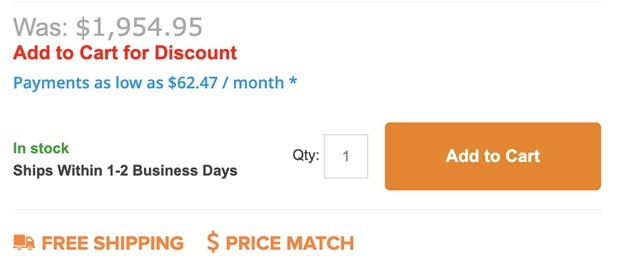Have you ever wondered why some retailers, like Amazon or Google Shopping, show “See Price In Cart” instead of a price on the product page?
A retailer may say “See Price In Cart” as a way to avoid advertising a product at a price lower than the manufacturer’s Minimum Advertised Price (MAP) policy. The acronym MAP may be unfamiliar for most consumers but to Brands, Manufacturers and Distributors that want to protect their brand and ensure they are making a profit on their products MAP and MAP policies are a huge deal. MAP is not MSRP, which some consumers may be familiar with.
As a refresher MSRP stands for Manufacturer’s Suggested Retail Price, it is a recommended selling price set by the manufacturer of a product for its retailers to sell the product at. It is the price at which the manufacturer believes the product should be sold and it can serve as a guide for retailers to set their own prices.
MAP policies are established by manufacturers or distributors to control the lowest price at which a product can be advertised, and retailers who have signed specific reseller agreements or a MAP agreement are required to comply with these policies.
By saying “See Price In Cart,” a retailer can avoid advertising a product at a price lower than the MAP, while still offering discounts or promotions to customers. This allows the retailer to comply with the MAP policy while still being able to offer competitive prices and attract customers.
Additionally, some retailers may use this technique as a way to increase the chances of customers adding the products to the cart, and therefore increasing the likelihood of a sale.
“See Price In Cart” is a common way for retailers to comply with MAP policies, while still being able to offer competitive prices and attract customers. It allows them to avoid advertising a product at a price lower than the manufacturer’s Minimum Advertised Price while still being able to offer discounts or promotions to customers.
But let’s consider some of the negatives when it comes to a Retailer advertising a price below MAP and not using “See Price In Cart”.
- Damage to brand reputation: Retailers advertising products at prices lower than the manufacturer’s suggested retail price (MSRP) can damage the brand’s reputation by creating the perception that the product is not worth the MSRP.
- Price erosion: Advertising products at prices lower than the MSRP can lead to price erosion, where the perceived value of the product is lowered and it becomes difficult for the brand to maintain its pricing strategy.
- Loss of business: Brands may cease business with retailers who violate their MAP policy, which can result in a loss of sales and revenue for the retailer.
- Unfair competition: Retailers who violate MAP policies may gain an unfair advantage over other retailers who are following the policy, which can lead to resentment and a lack of trust among retailers.
- Legal issues: Brands may take legal action against retailers who violate their MAP policies, which can result in costly legal fees and potential damage to the retailer’s reputation.
- Loss of authorization: Brands may revoke the authorization of retailers who violate their MAP policies, which can lead to a loss of access to exclusive products, promotions and marketing support.
- Loss of trust: Brands may lose trust in retailers who violate their MAP policies and may be less likely to work with them in the future.
How do Brands police their retailers?
- Monitoring prices manually: Brands may manually check prices on online marketplaces and retailers’ websites to detect MAP violations. This method can be time-consuming, but it can also be useful for detecting subtle or nuanced violations that automated systems might miss.
- Using automated price scraping software: Brands may use automated price scraping software to check prices on online marketplaces and retailers’ websites. This software can check prices in real-time and alert the brand when a violation occurs. automated price scraping software can be more efficient than manual monitoring, but it may not be able to detect subtle or nuanced violations.
- Using a MAP monitoring software: Brands may use a third-party MAP monitoring software to check prices on online marketplaces and retailers’ websites. This service can provide brands with a more comprehensive view of prices and provide ready to consume MAP violation exceptions reports.
What brands are good examples for having effective MAP policies?
Have you ever wondered why you cannot find a deal on Apple Products? That is because Apple aggressively monitors for MAP violations and strictly enforces their MAP agreements. If a retailer wants to ever carry Apple Products again then they need to play ball. This aggressiveness and the popularity of Apple products compel retailers to fall in line. Similarly GoPro is another example of a company who monitors their products with zeal looking for MAP violators. Both Apple and GoPro have a zero tolerance policy and if they find a retailer in violation of the MAP / Reseller Agreements they will terminate them pretty much immediately.
So in conclusion “See Price In Cart” is a functional way to circumvent a MAP agreement the retailer has directly with a Brand or Manufacturer. This method allows the retailer to offer more attractive pricing while not violating the terms it may have with the Brand. Additionally, the nature of cart pricing makes it more difficult for web scrapers to automatically scrape price data.


